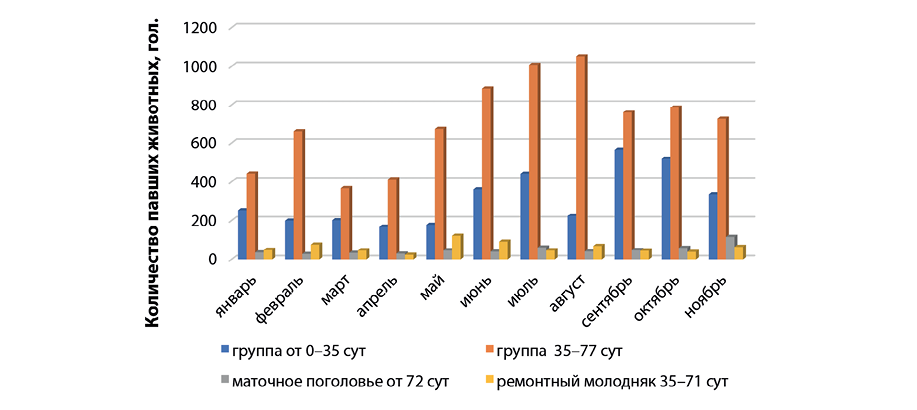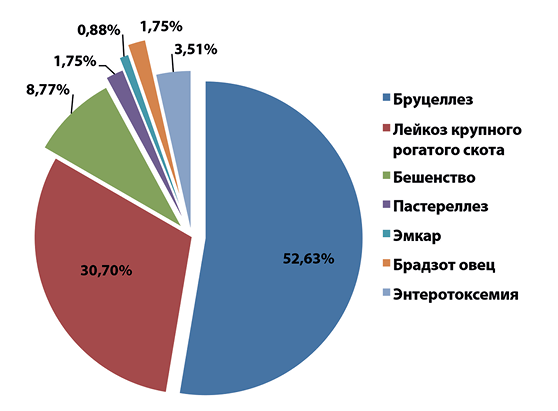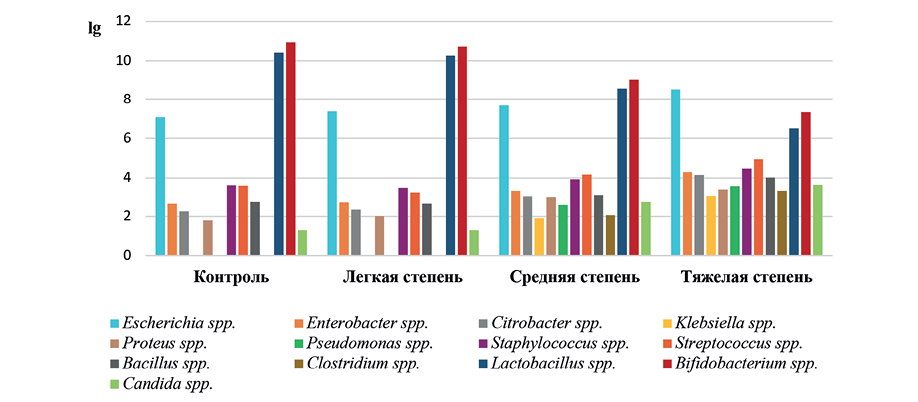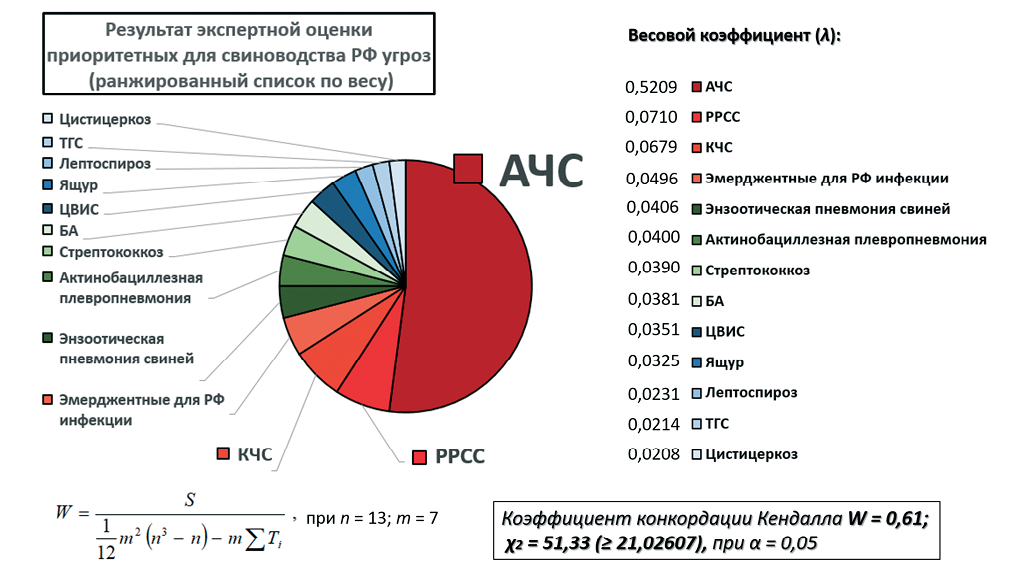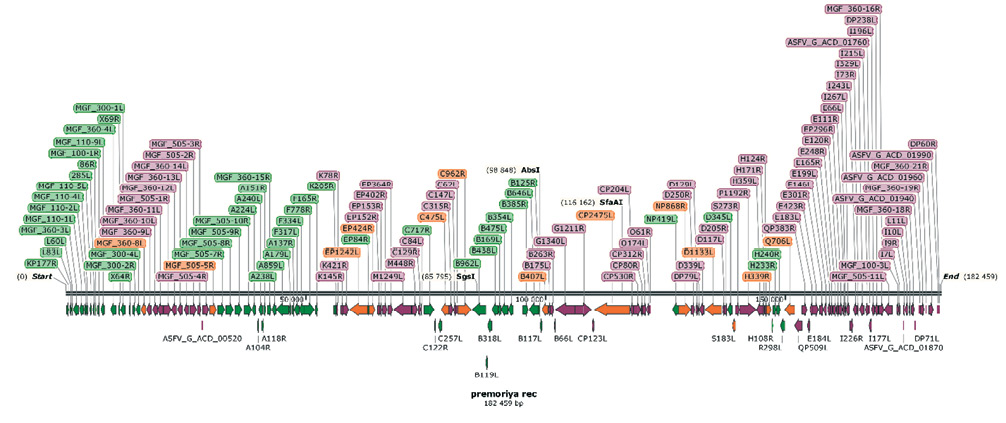REVIEWS | BOVINE DISEASES
Mastitis remains the most common problem of dairy industry despite the preventive measures and treatment schemes being developed. Antibacterial drugs remain first line agents for therapy of the mammary gland inflammatory diseases in animals. Taking into account the risks associated with antibiotic therapy, such as decreased drug effectiveness due to occurrence of bacterial resistant strains, food safety issues, environmental impact and restrictions on the use of antibacterial drugs in veterinary medicine, an increasing number of scientific studies are addressing new therapeutic agents that can serve as an alternative to conventional therapy. The aim of this review is to give an idea of currently available literature data on alternative methods for the prevention and treatment of mastitis in cattle that are not associated with antibiotics. In general, a significant number of in vitro studies aimed at finding new effective and safe drugs are yielding promising results. This review describes the following alternative remedies: probiotics, bacteriocins, bacteriophages, phage enzymes (endolysins), nanoparticles, plant extracts, essential oils and immunobiological agents (vaccines). Understanding the mechanisms of their action will allow recommending the best treatment option for mastitis in each specific case. These treatment methods can potentially reduce use of antibiotics and increase animal productivity, however more in vivo studies are needed to prove the effectiveness of antibiotics used directly in the conditions of farm settings.
ORIGINAL ARTICLES | ANIMAL RABIES
Rabies is a zoonotic viral disease of all warm-blooded animals caused by a neurotropic virus, member of the Lyssavirus genus of the Rhabdoviridae family. About 59,000 people die from hydrophobia globally every year. According to the World Health Organization, the red fox (Vulpes vulpes) and the common raccoon dog (Nyctereutes procyonoides) are the main reservoirs and vectors among carnivores of the rabies virus in Europe. The paper describes animal rabies situation in 2011–2023 and the role of oral vaccination of wild carnivores against rabies in the Moscow Oblast. The region is a part of the Central Federal District and located in the center of the Russian plain bordering seven Oblasts (Tver, Smolensk, Kaluga, Tula, Ryazan, Vladimir and Yaroslavl Oblasts), which are also rabies infected. Notwithstanding the metropolis growth, the number of wild carnivores in the Moscow Oblast remains high. Comprehensive preventive measures to control the population of the wild carnivores are taken to stabilize the rabies situation and decrease the incidence, innovative achievements in laboratory diagnosis are introduced, population immunity of wild carnivores by oral vaccination is improved and the epidemic situation in neighboring regions is analyzed. In 2017 the systemic, consistent and thoroughly organized campaign was started – the oral vaccines were distributed by light aircrafts. The research revealed the correlation between the decrease in annual number of reported rabies cases and increase in the amounts of oral vaccines distributed. The use of controlling devices (camera traps) confirmed that oral rabies vaccines are consumed by the target animals (red foxes). The onward systemic, methodical approach to rabies prevention will mitigate the risks of rabies occurrence in the Moscow Oblast.
ORIGINAL ARTICLES | PORCINE DISEASES
Classical swine fever (CSF) remains a challenge for pig farming industrial lover the world despite the measures taken. The last CS case in the Russian Federation was reported in 2020, however, the threat of the disease emerging still persists. A set of anti-epidemic measures including mainly preventive vaccination and annual diagnostic monitoring using molecular-genetic and serological methods is required for CSF virus introduction prevention and rapid eradication of potential disease out breaks. Therefore, areal-time reverse transcription-polymerase chain reaction using an internal control sample has been developed. Therefore, areal time reverse transcription-polymerase chain reaction using an internal control sample has been developed. Modified primers (locked nucleic acids containing conformationally blocked nucleosides) providing a higher affinity to the DNA matrix and physico-chemical stability and a FAM-labeled TaqMan probe were selected for 5’-untranslatedregion of the genome. The following validation parameters were defined: accuracy, repeatability, reproducibility, specificity and sensitivity. For comparative analysis of the developed as say sensitivity, swabs, samples of organs and tissues collected from pigs experimentally infected with an epizootic strain of the classical swine fever virus (spleen, kidney, liver, blood, lymph nodes, rectal and oral smears), animal-contaminated feed and virus-containing material with known virus titres were also tested in parallel with coded test systems No. x1 andx2. The developed assay was shown to have 100% diagnostic sensitivity and detection limit of 0,23 lgCCID50/cm3. Therewith, there sults of analysis of test systems No. x1, x2 based on above parameters were lower that could give rise to false positive real-time RT-PCR results and incorrect diagnosis. Thus, described assay can be used for extensive monitoring of classical swine fever in the Russian Federation
ORIGINAL ARTICLES | DISEASES OF SMALL PETS
Enterotoxemia, accompanied by diarrhea and bloating, is still a matter of pressing concern to the rabbit farming. Clostridia bacteria are often isolated from the internal organs of rabbits that have died of an anaerobic infection. Clostridial infection, manifested in various forms, is a major problem for veterinarians. The following drivers contribute to the emergence of the infectious disease: malnutrition (insufficient fiber intake); non-compliance with hygiene requirements for animal handling; unsustainable use of antibacterial drugs; gastrointestinal congestion. All these drivers can disrupt healthy caecum microflora due to changes in the gastrointestinal environment. Low-fiber diets result in slow cecum motility, thus, delaying transit of the intestinal contents and eventually changing the microflora. Use of antibiotics together with stress make Clostridia accumulate in the gastrointestinal tract, at the same time, reducing the number of microorganisms of other groups. The first signs of toxicoinfection are observed when rabbit kits are weaned from does. Clinical manifestation begins with bloating, weakness, inappetence, which ultimately lead to death. Observations have shown that the risk group includes rabbit kits weaned from the 35–77-day old does. Mortality was less reported in breeding stock and among replacement young animals. Autopsy revealed signs of enterotoxemia: serous-catarrhal gastritis, serous-hemorrhagic lymphonodulitis, degenerated kidneys, liver and heart muscle; passive congestion of lungs and pulmonary edema. Microbiological diagnosis revealed Clostridium histolyticum and Clostridium perfringens species known for their pronounced toxigenic profile, most often bacteria were found in the stomach, intestines and heart.
ORIGINAL ARTICLES | AVIAN DISEASES
The most common disease of young poultry in commercial farms of the Russian Caspian region is eimeriosis. In most cases, after convalescence from coccidiosis caused by one of Eimeria species poultry remains susceptible to other species. This parasite has a very short life cycle and immense reproductive capacity that is why it can cause large-scale outbreaks of the disease in commercial poultry houses. To control avian eimeriosis, various coccidiostats are used in combination with probiotics and vitamins. Frequent and long-term use of the same drugs against this infection can potentially result in the emergence of resistant Eimeria populations. This suggests that this coccidiosis control requires rotation of eimeriocidal drugs. Studies on eimeriosis prevalence were performed in the laboratory of the Caspian Regional Research Veterinary Institute and in different poultry farms of the Republic of Dagestan. Swabs of the floor, litter, equipment, droppings, feedstuffs, cecum smears from dead poultry were used for testing. High infection rate with eimerias was established in floor-housed poultry in the plain and piedmont zones of the Republic (Khasavyurtovsky and Karabudakhkentsky raions), where the infection rates were 81.6 and 82.4%, respectively. In batter-cage system poultry farms of the mountain and mountain valley zones (Khunzakhsky and Gergebilsky raions) the infection rates were significantly lower – 61.2 and 58.0%, respectively. The comparative efficacy study of two eimeriocidal drugs showed that “Robenidine”, used daily from the first day of life during the entire rearing period at a dose of 33 g per 1 ton of feedstuffs controls coccidiosis in poultry. At the same time, the survival rate of the experimental young poultry during the observation period was 98.0% compared with “Sarucoxum 12%” group (96.7%).
“ARRIAH-AviFluVac” vaccine against H5 avian influenza was demonstrated to be effective for ducks, geese and turkeys both in the laboratory and production environment. When administered to ducks at 0.5; 1.0 and 1.5 cm3, the vaccine provided 100%-effective protection of birds against the disease and death after challenge with the relevant high pathogenicity avian influenza virus of subtype H5N1, clade 2.3.4.4b. Singular 0.5–1.5 cm3 inoculation induced formation of antibodies, which were detected in the hemagglutination inhibition test at the titres that ranged from 4.3 to 6.1 log2. The vaccine facilitated 9–26-fold decrease in the virulent virus shedding by the ducks. Protection of turkeys vaccinated at the dose of 1.0 cm3 was maintained at the level of 87.5% after challenge with high pathogenicity avian influenza virus of subtype H5N1, clade 2.3.4.4b. The vaccine induced formation of antibodies at the titres of 4.9 and 5.5 log2 in turkeys after singular and double vaccination at the dose of 1.0 cm3, respectively. It was demonstrated, that after double administration of 1.0 cm3 of “ARRIAH-AviFluVac” vaccine, the post-vaccinal avian influenza antibody level exceeded 5.0 log2 in 75.9–90.0% of the geese population. The most appropriate way of the vaccine use in turkeys, ducks and geese involves at least its double administration at the double commercial dose. Higher species resistance of ducks to the challenge with avian influenza virus of subtype H5, clade 2.3.4.4bas compared to turkeys was also demonstrated.
REVIEWS | EPIZOOTOLOGY
An epizootiological survey of livestock farms of Dagestan was conducted, the main infectious diseases common in the region were considered, and measures taken to protect against them were described. At present, the Veterinary Service is undertaking systematic efforts to prevent the occurrence and spread of infectious diseases such as brucellosis, leukosis, rabies, pasteurellosis, blackleg, bradsot and enterotoxemia in the Republic. Among the above-mentioned diseases reported in 2023, brucellosis and leukosis are responsible for the vast majority of outbreaks and diseased animals detected in them. In particular, the following diseases have the largest share in the nosological profile of quarantinable infectious diseases based on the number of detected infected localities during the period under study: brucellosis (52.63%), bovine leukosis (30.70%), rabies (8.77%), enterotoxemia (3.51%), pasteurellosis (1.75%), bradsot (1.75%) and blackleg (0.88%). In total, 1,812 animals were affected with quarantinable infections and 35 animals died in 114 infected localities. Most often over the past year, quarantinable infections were reported in cattle (69.59% of cases) and small ruminants (29.36%); in 1.05% of cases, the diseases affected horses, cats, wild animals and birds. In order to maintain animal disease freedom and sustainable growth of livestock production, the Veterinary Committee of the Republic of Dagestan annually implements measures to prevent the occurrence and spread of 75 diseases of animals and birds, including 10 highly dangerous ones. Anti-epizootic measures taken in the past year included a total of 93.8 million vaccinations and 6.2 million tests performed in the diagnostic institutions. Plans for the prevention of highly dangerous and other contagious diseases of animals and birds were fully implemented.
ORIGINAL ARTICLES | VETERINARY MICROBIOLOGY
Due to the growing threat of antimicrobial resistance, the search and development of new drugs to treat infectious mammary gland diseases of high yielding cows is an urgent task. The paper presents data on the microbiota composition of milk from high yielding cows suffering from subclinical mastitis; 144 microbial isolates were recovered from 70 milk samples; with the highest number of Staphylococcus aureus and Streptococcus dysgalactiae detected (22.2 and 16.0%, respectively). The study showed that a significant number of Staphylococcus aureus isolates (53.1%) were resistant to I generation cephalosporins; 52.6% of the isolated Streptococcus dysgalactiae strains showed resistance to tetracyclines; 33.3% of Staphylococcus haemolyticus isolates were resistant to macrolides. 42.1; 35.3 and 62.5% of Enterococcus faecium, Aerococcus viridans and coliform bacteria isolates, respectively, were resistant to penicillins. 38.5% of Staphylococcus epidermidis isolates were found to be resistant to tetracyclines. Corynebacterium pseudotuberculosis isolates showed equal resistance to penicillin and tetracycline antimicrobials (20.0%). The research revealed presence of multi-drug resistant coliform bacteria, Streptococcus dysgalactiae, Aerococcus viridans, Staphylococcus aureus strains. Experiments to study the effect of the new nisin-based pharmaceutical formulation on microbiota of milk from cows with subclinical mastitis were carried out using 35 high yielding cows. A microbiological testing of cow milk on day 14 from the beginning of the treatment showed that the number of microbiota-free samples increased to 88.6%, while in 1.4% of cases Staphylococcus aureus isolates were recovered (103 CFU/mL). The titers of coliform and Staphylococcus aureus bacteria isolated in 1.4% (101 CFU/mL) and 2.7% (102 CFU/mL) of cases, respectively, were not etiologically significant.
Formation of biofilms of microorganisms, including those of Nakaseomyces glabratus, is responsible for the development of local and systemic pathologies in humans and animals. The system of gene expression coordination (quorum sensing) in the representation of signaling molecules allows regulation of the amount and composition of biofilm populations thus expanding the adaptive capacity of microorganisms. In the presence of gingivitis and odontolithiasis clinical signs in dogs, excessive growth of gram-positive yeast microorganisms is a differential sign of the decreased resistance of the digestive system mucous membranes to colonization. Examination of the densitometric and morphometric parameters revealed general patterns of biofilm formation, regardless of the source of Nakaseomyces glabratus isolates. Depending on the time of cultivation of the microorganisms, a gradual increase in the optic density absolute values was established. Intercellular communications were achieved by coaggregation of the heteromorphic structures, which formed clusters with rounded liquid-containing formations detected among them. The population immobilization of the architectonics of the mature three-dimensional biofilm, as consistent with cultivation conditions, was accompanied by the differentiation of numerous cells of different sizes and shapes depending on the stage of the cell cycle. Results of the examination of the general patterns of the heterogeneous micromycete population development are promising for expanding the boundaries of knowledge of the adaptation mechanisms of ubiquitous microorganisms to long-term in vivo and in vitro persistence. Methods for studying morphometric and densitometric indicators avoiding interfering into the natural biofilm architectonics are recommended to optimize the long-term and retrospective mycological studies, as well as to develop effective mycosis treatment and prevention regimens.
The intestinal barrier is one of the most important components that maintain gastrointestinal homeostasis, therefore changes in bacterial composition can lead to increased intestinal permeability and the development of intestinal translocation of opportunistic microorganisms, with the subsequent development or complication of various infectious diseases. A comparative description of the microbiota of the intestinal tract of calves with compensated, subcompensated and decompensated acute catarrhal bronchopneumonia of calves was carried out in the conditions of livestock farms of Vladimir and Moscow Oblasts. Calves aged 1–3 months with acute catarrhal bronchopneumonia (n = 37) were used for the study. The severity of the disease was assessed based on clinical and laboratory tests. The samples taken from clinically healthy animals (n = 8) were used as controls. It has been shown that in calves with compensated acute catarrhal bronchopneumonia, the qualitative and quantitative composition of the intestinal microbiome does not differ from clinically healthy animals. During the clinical manifestation of subcompensated and decompensated acute catarrhal bronchopneumonia in calves, a significant quantitative and qualitative shift in the microbiome occurs in the intestines, which indicates the occurrence of dysbiosis. We believe that this area is quite relevant and requires further scrupulous research.
ORIGINAL ARTICLES | GENERAL ISSUES
The results of the situational analysis on porcine diseases in the Russian Federation and the expert assessment prioritizing the list of porcine pathogens significant for the pig industry of the country are presented. The method applied to analyse the expert estimates in the situational analysis allows for rapid assessment and interpretation of the situation with identification of priority diseases to be further addressed. The calculations demonstrated the sufficient degree of agreement among the experts (coefficient of concordance W = 0.61), and Pearson’s chi-squared test statistic χ2 = 51.33 (≥ 21.02607) indicated that the concordance is not random and the results can be used in subsequent studies. The specific features of epizootiology of the agents of African swine fever, classical swine fever, porcine reproductive and respiratory syndrome that can impact the effectiveness of biosecurity systems of pig establishments, as well as further ways for improving biosecurity management measures are discussed. The overall risk for the pig industry in the Russian Federation that is associated with external sources is currently characterized as permanently high, requiring maintaining risk management measures at the pig establishments by both the managerial staff of the establishments and the State Veterinary Service. It is recommended that biosecurity measures against external threats should focus on diseases such as African swine fever (weight λ = 0.52), porcine reproductive and respiratory syndrome (λ = 0.071), classical swine fever (λ = 0.068) and infections considered emerging for the Russian Federation (λ = 0.05) according to the weights based on the expert estimation results. The biosecurity systems of the establishments should equally address other threats significant for the pig industry of the country: swine enzootic pneumonia, porcine pleuropneumonia (Actinobacillus pleuropneumoniae), Aujeszky’s disease, streptococcosis (Streptococcus suis), porcine circovirus infection, foot-and-mouth disease, leptospirosis, transmissible gastroenteritis, cysticercosis (λ = 0.02…0.05). The improvement of the governmental policy for eradication of African swine fever, porcine reproductive and respiratory syndrome, classical swine fever (including the substantial modification of the existing official pig turnover control, zoning, diagnosis and prevention quality, as well as the implementation of biosecurity standards) is the most significant factor, without which the disease eradication perspective is questionable.
Currently, veterinarians pay much attention to the diagnostic examination of animals, including animals kept on fur farms. Blood is the main material used for such examinations. Changes in its composition allows veterinary practitioners to identify disorders in various systems and organs of animals, as well as to assess metabolism in animals. Results of biochemical tests of serum samples from platinum fox males and females of different age groups and comparative assessment thereof are presented. The levels of aspartate aminotransferase (U/L), alanine aminotransferase (U/L), alkaline phosphatase (U/L), total protein (g/L), albumin (g/L), urea (mmol/L), creatinine (μmol/L), α-amylase (U/L), cholesterol (μmol/L) were determined. Aspartate aminotransferase levels in females at the age of 6 months were lower by 69% than that ones in males. Increase in aspartate aminotransferase by the age of 6 months helps animals to accumulate body weight before winter. Sexual differences in the alkaline phosphatase levels were detected in 1.5-month-old kits: alkaline phosphatase levels were higher by 21.05% in males than in females. By the age of 6 months, the alkaline phosphatase levels decreased in both males and females. The decline in alkaline phosphatase level with the age is associated with participation of this enzyme in the development of animal skeleton during ontogenesis. From the age of 4 months, the growth and development of the skeleton slows down, and by the age of 6 months the animals gain the size and body weight of adult animals. Urea and creatinine levels in foxes of both sexes increased during their growth, but remained within the reference limits. Changes in urea levels in blood can be caused by feeding excessively high-protein or excessively low-protein diets. The total protein content in sera from 4 month-old males and females decreased by 32.51 and 43.24%, respectively, compared with that one in sera from animals at the age of 1.5 months, and increased at the age of 6 months up to the level observed at the age of 4 months. According to the literature, rather rapid stabilization of protein metabolism is a biological feature of many mammals born in spring, their growth rate is accelerated and, in general, the maturity phase is shortened.
BRIEF COMMUNICATIONS
As part of extensive molecular and genetic research into African swine fever virus isolates circulating in Russia, a recombinant variant with a mosaic genome structure has been identified. The one that caused an outbreak on a pig farm in the Primorsky Krai, in 2023. The characterized strain ASFV/Primorsky_2023/DP-4560.Recdemonstrates hemadsorption, active propagation in porcine primary macrophage cell culture, 99.9917% identity with the first recombinant isolates from the People’s Republic of China, recovered in 2021. Recombination sites included 79 open reading frames homologous to genotype II isolates; 49 ones homologous to genotype I and 12 mixed ones. Testing biomaterial from dead pigs in real-time polymerase chain reaction showed no changes in sensitivity or specificity, despite significant genetic distinctions between the recombinant and genotype II isolates that are enzootic to the Russian Federation. However, in 2023, D. Zhao et al. reported on high virulence of the virus related variants as revealed by the challenge tests in domestic pigs. Given the accelerating rates of AFSV molecular evolution in the East Asian countries (China, Vietnam and the Far Eastern regions of Russia), it is required to improve control measures, general and specific prevention, national and international surveillance over the economically significant animal disease.
ISSN 2658-6959 (Online)






